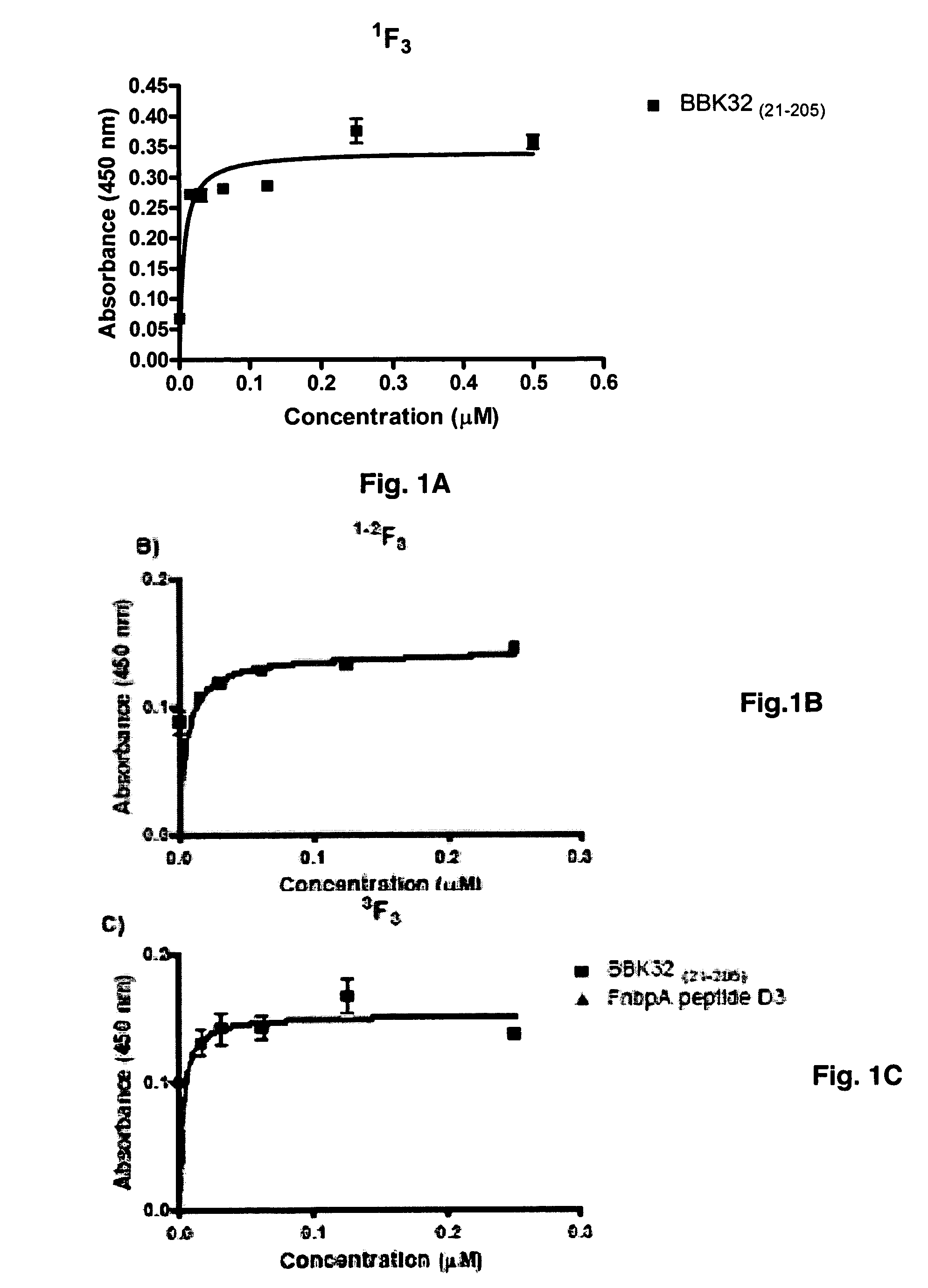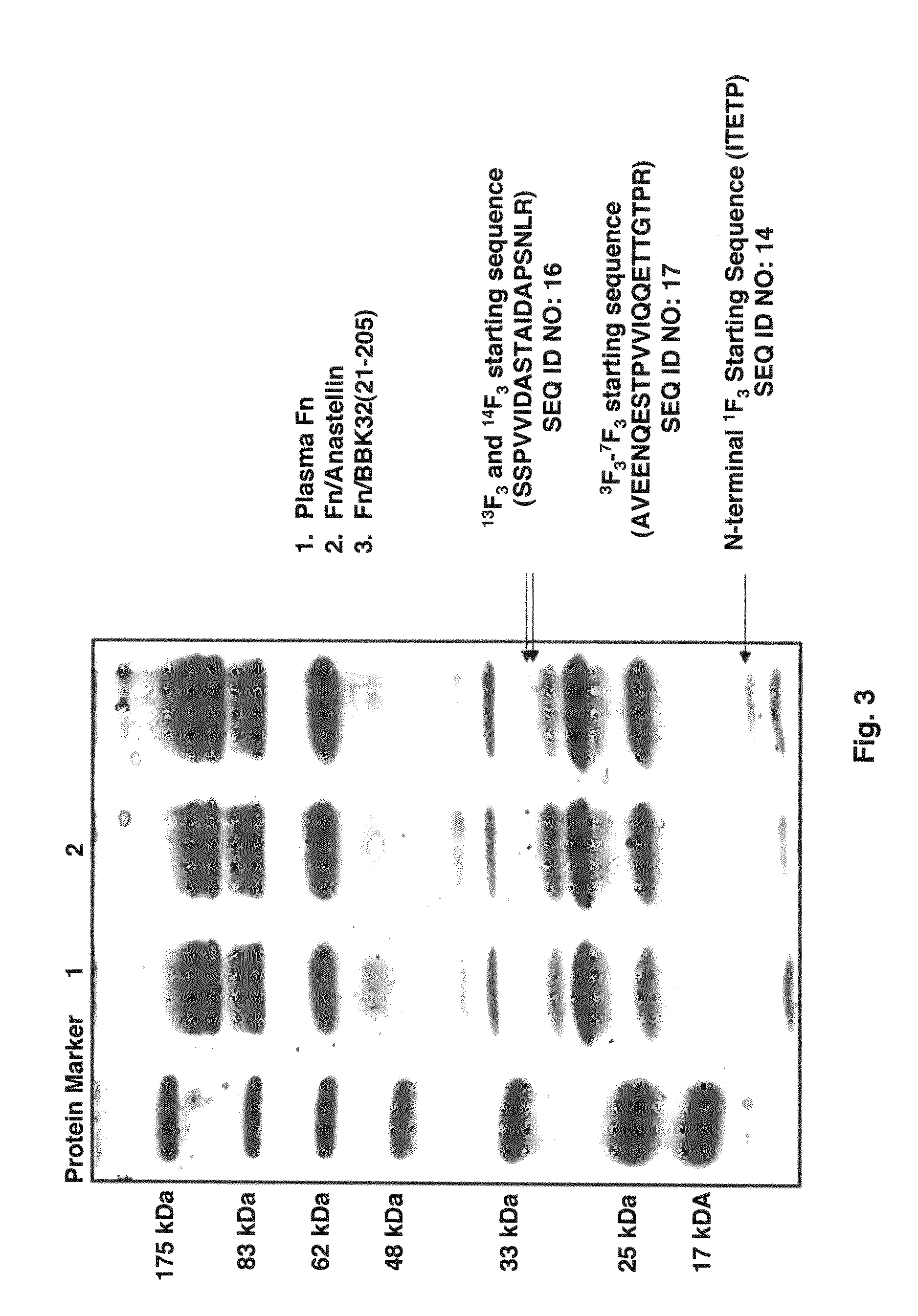Formation of superfibronectin by BBK32 and uses therefor
a superfibronectin and bbk32 technology, applied in the field of protein molecular biology and pathogenic microbiology, can solve the problems of complex life cycle, oscillation, and prior art deficient in methods of inducing superfibronectin aggregation, and achieve the effect of inhibiting the proliferation of endothelial cells
- Summary
- Abstract
- Description
- Claims
- Application Information
AI Technical Summary
Benefits of technology
Problems solved by technology
Method used
Image
Examples
example 1
Proteins
[0046]The Anastellin construct was provided by Dr. Paula McKeown-Longo (Albany Medical College). A recombinant Anastellin protein (SEQ ID NO: 1) with a C-terminal His-tag was produced in bacteria and purified (21-22). Recombinant BBK32(21-205) was expressed and purified as described (6). Recombinant F3 modules are 1F3 (SEQ ID NO: 2), 1-2F3 (SEQ ID NO: 3) and 3F3 (SEQ ID NO: 4) were expressed with N-terminal His-tags and purified by standard Ni-NTA and ion-exchange chromatography. FnbpA peptide D3 was synthesized and purified by HPLC using previously described methods (23). Plasma fibronectin was affinity purified from human plasma (Gulf Coast Regional Blood Center Houston, Tex.) as described previously (24).
Anastellin. fibronectin and BBK32 sequencesProtein / PeptideSequenceRecombinant AnastellinNAPQPSHISKYILRWRPKNSVGRWKE(SEQ ID NO: 1)ATIPGHLNSYTIKGLKPGVVYEGQLISIQQYGHQEVTRFDFTTTSTSP1F3SSGPVEVFITETPSQPNSHPIQWNAP(SEQ ID NO: 2)QPSHISKYILRWRPKNSVGRWKEATIPGHLNSYTIKGLKPGVVYEGQLISIQQ...
example 2
BBK32 Binds to 1-3F3 in Fibronectin
[0053]BBK32 binds to the 1F1-5F1 N-terminal segment of fibronectin by the tandem beta-zipper mechanism (6-7). Experiments designed to further define the MSCRAMM binding sites in fibronectin by probing a thermolysin digest of fibronectin with BBK32(21-205) in Far Western blots indicated that the MSCRAMM binds more strongly to the 56 kDa fragment than to the 45 kDa gelatin binding fragment. Since the only difference between these two fibronectin fragments is the inclusion of 1F3 in the 56 kDa fragment, this result suggests that BBK32(21-205) may interact with the 1F3 module.
[0054]Pure recombinant forms of 1F3, 1-2F3, and 3F3 were generated and examined the binding of BBK32 to these fibronectin modules was examined in an ELISA-type binding assays. BBK32 bound all three F3 modules in concentration dependent processes. The binding to the 1F3 module was specific to BBK32 as the D3 fragment of S. aureus FnbpA, which has a high affinity for 1F1-5 μl, did n...
example 3
BBK32 Aggregates Plasma Fibronectin in a Concentration Dependent Manner
[0055]The interaction of BBK32(21-205) with 1F3 and 3F3 is particularly interesting since Anastellin, the only known inducer of sFn, also binds to these modules (25). This similarity raises the possibility that BBK32 can induce an ordered form of fibronectin aggregation. To test this possibility 1 μM of purified plasma fibronectin was incubated with increasing concentrations of BBK32(21-205), Anastellin, or the FnbpA D3 fragment. BBK32 and Anastellin, but not the D3 protein induced fibronectin aggregation that could be followed by the increase in absorbance at 600 nm (FIG. 2A). Fibronectin aggregation was dependent on the concentration of the inducer, and Anastellin and BBK32(21-205) showed very similar activity with aggregation initiated at 20 μM or above. Aggregation of fibronectin was also observed with full length BBK32, which includes the C-terminal globular domain (residues 21-354) (FIG. 2b). BBK32(21-354) ...
PUM
| Property | Measurement | Unit |
|---|---|---|
| pH | aaaaa | aaaaa |
| pH | aaaaa | aaaaa |
| ionic interactions | aaaaa | aaaaa |
Abstract
Description
Claims
Application Information
 Login to View More
Login to View More - R&D
- Intellectual Property
- Life Sciences
- Materials
- Tech Scout
- Unparalleled Data Quality
- Higher Quality Content
- 60% Fewer Hallucinations
Browse by: Latest US Patents, China's latest patents, Technical Efficacy Thesaurus, Application Domain, Technology Topic, Popular Technical Reports.
© 2025 PatSnap. All rights reserved.Legal|Privacy policy|Modern Slavery Act Transparency Statement|Sitemap|About US| Contact US: help@patsnap.com



